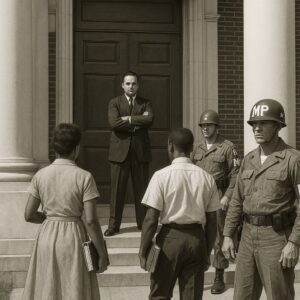On June 11, 1963, the University of Alabama became a powerful symbol of America’s struggle with civil rights and racial equality. That day, Governor George Wallace made his infamous “Stand in the Schoolhouse Door,” physically blocking the entrance to prevent two African American students, Vivian Malone and James Hood, from enrolling. His bold act of defiance was a stark reminder of the deep resistance to desegregation in the South.
Wallace’s stand wasn’t just a personal protest—it was a calculated political statement against the federal government’s efforts to enforce civil rights laws. The University of Alabama had long been segregated, reflecting the widespread system of racial discrimination that permeated many aspects of American society. But in 1963, the civil rights movement was gaining momentum, demanding that public institutions open their doors to all citizens regardless of race.
When Wallace stood in the doorway, President John F. Kennedy responded decisively, federalizing the Alabama National Guard to ensure that Malone and Hood could register safely. This moment became a defining episode of the civil rights era, highlighting the tension between state resistance and federal authority.
The courage of Malone and Hood, coupled with the firm actions of the federal government, helped pave the way for the dismantling of segregation across schools in the South. The “Stand in the Schoolhouse Door” remains a powerful symbol of the battle for equality, reminding us that progress often requires confronting entrenched opposition head-on.
This event not only reshaped the University of Alabama but also sent a clear message nationwide—that the fight for civil rights was unstoppable.

